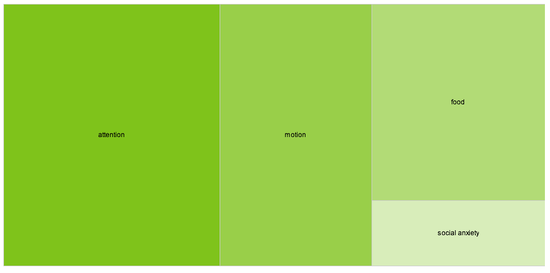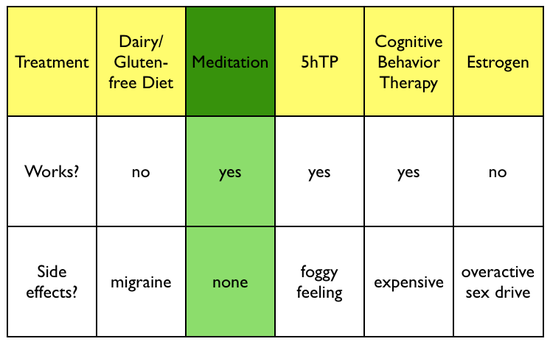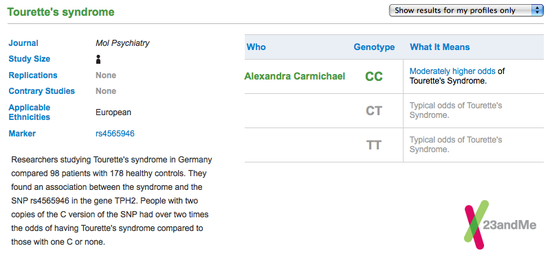What I Learned From Tourette’s
Alexandra Carmichael
July 3, 2010
6 months ago, I got my 23andMe genetic test results. They showed mostly what I expected: 30% chance of diabetes, 24% chance of atrial fibrillation, 40x greater risk of Celiac disease than the general population. All of these things are found in my extended family to some degree.
But there was one thing I didn’t expect.
I have double the normal risk of Tourette’s syndrome. Yes, Tourette’s is commonly associated with people walking down the street swearing and thrashing around uncontrollably. That’s not me, but it did get me thinking.
My dad, brother, and I all have tics. They had always bothered me, but I learned to internalize most of them so they aren’t noticeable unless you’re looking very carefully or I let down my guard. They are part of the reason that I can only see people 3 days a week, because I need the other 4 days to recover from the effort. I began to wonder, what if I could address the tics and live life with more ease? So, armed with the new 23andMe information, I started to investigate this part of my health that I hadn’t really looked at in detail before.
The first thing I did was to write down all the different tics I do, which are almost all on my left side. My theory as to why I don’t have many of the vocal tics characteristic of Tourette’s is that perhaps only my right brain is affected – so the right side of my body and my language center, both controlled by my left brain, are mercifully free.
Here are all the things I do, mostly involuntarily, every day (after the jump):
– shift my eyes quickly across bright lights or high-contrast things
– rotate my tongue around my lower front teeth
– tense and release my left shoulder
– scrape my heel across cracks in the sidewalk as I walk
– crunch up and release my toes in my shoes
– scratch my head
– clean under my fingernails
– rub the flap of my cheek flap with my thumb
– dig my nails into my gums (to the horror of my dentist)
– strongly blink my eyes
– tense and release my left inner thigh
– wiggle my toes in a particular pattern
– stare down the side of my nose, often combined with a strong blink
– wipe my thumb across the corners of pages as I read
– swish food around my mouth in a very specific pattern
– rub my fingers against the little tabs on the f and j keys of my keyboard
– scuff my toe on the sidewalk or against the stroller wheel if I’m pushing it
– step on cracks with the ball of my foot, if I’m not scraping over them
– shift my heel inside my shoe as i walk
– rock in an uneven chair
– step across a line of sun-shadow, often combined with staring down the side of my nose and a strong blink
– grind my molars
The first of these tics started in childhood, and the list grew during stressful periods like high school, college, and postpartum. As far as I can tell, it could be classified as Chronic Multiple Tic Disorder, which is on the Tourette’s spectrum. But whatever it’s called is less important than the effect it has on my life.
After being surprised by the number of tics I hadn’t realized I do every day, the next thing I did was to make a list of what triggers or exacerbates the tics:
– stress
– excitement
– change
– social isolation, or wanting attention
– social anxiety, which is in direct conflict with social isolation
– lack of sleep
– transportation, or just being physically moved
– boredom
– clothing on skin, like tags, seams, or tight areas
– light/dark contrast
– sensitivities to light/sound/touch/smell, especially when I’m overtired
– eating, or worrying about body image
– cloudy/rainy days
– obsessive hypercycling thoughts
The last one on the list deserves further explanation. I haven’t seen any research on this, but in my experience, thoughts can tic just like bodies can tic. My mind will fixate on a particular thought and repeat it over and over and over again until I take some action to release it. This is very helpful to me in work situations, because it enables an incredible productivity that I might not be able to sustain otherwise. It is less helpful in other life situations, especially when my mind decides to fixate on inappropriate social behaviors that require an immense effort for me to hold back.
In January, I decided to track 4 of these thought patterns that were particularly distressing, to see how often they happened relative to each other. I used Your Flowing Data to capture the data, using the free iPhone app YFDUploader as an interface for easier on-the-go recording of thoughts. The four thoughts I tracked were: need for social attention, need to move my body, worry about food, and social anxiety. Each of these could be its own blog post, but here is the distribution I found.
 The need for attention stood out because I had just had to break off a dear relationship, but it surprised me that I was spending such a huge amount of time thinking about it. The motion tic is sort of background, always there. The food one is related to body image, which I am almost always worried about in one way or another. And the social anxiety one was probably related to phone calls I had to make to continue my work while living in Hawaii for the winter, but I had expected it to be a greater fraction of the chart.
The need for attention stood out because I had just had to break off a dear relationship, but it surprised me that I was spending such a huge amount of time thinking about it. The motion tic is sort of background, always there. The food one is related to body image, which I am almost always worried about in one way or another. And the social anxiety one was probably related to phone calls I had to make to continue my work while living in Hawaii for the winter, but I had expected it to be a greater fraction of the chart.
The next thing I decided to do was explore and test ways that I could ease the physical and mental tics. I made another list of things I thought helped me:
– peace and quiet
– touch
– exercise
– being in nature
– playing and listening to music
– 5hTP
– estrogen
– meditation
– focusing on work or an intensive task
– playing games
– having plans/structure/control
– dietary changes, specifically targeting dairy and gluten
– talk therapy
I started experimenting with each of these, choosing a simple, binary outcome measure: at the end of the day, did I feel like I had been particularly bothered by tics that day, or not? And did I experience any side effects? For dietary changes and therapy, I experimented for 3-4 weeks, since it takes longer to see effects. For the others, 1-2 weeks was enough to notice a difference. My treatment bias was that I wanted to avoid drugs at all costs, especially if lifestyle changes could be effective.
Here is a subset of my results:
 Meditation came out as the clear winner here – it’s free, has no side effects, and 25 minutes a day makes a significant difference in the amount of tics in my day. Right now I’m combining it with weekly Cognitive Behavior Therapy, and the occasional 5hTP when I am feeling particularly distressed. I still have a ways to go, but I feel happy to be on a path to an easier life.
Meditation came out as the clear winner here – it’s free, has no side effects, and 25 minutes a day makes a significant difference in the amount of tics in my day. Right now I’m combining it with weekly Cognitive Behavior Therapy, and the occasional 5hTP when I am feeling particularly distressed. I still have a ways to go, but I feel happy to be on a path to an easier life.
So what did I learn from Tourette’s? I learned to be gentle with myself – to accept my differences and allow myself to accommodate and address them instead of criticizing myself for not being like everyone else. I learned how little is really known about mental health – we pay so much attention to taking good care of our physical bodies, but don’t do much for our minds. I learned to meditate and to wear comfortable clothes. I learned to be curious about how different minds think about things, and I learned greater compassion for people living with poorly defined neurological conditions. I learned how lucky I am to have such an incredibly supportive life partner, and I learned once again the power of self-experimentation to find a personalized combination of effective remedies.
Going back to genetics for a second, and the scary vulnerability of this post – I wanted to write out my experience partly to help my two daughters, who may grow up to experience similar things. And I wanted to help them consider the larger question that emerges with Tourette’s and other neurological conditions, given the advantages in different forms of cognitive capacity that can be associated with them:
Do we cure, or celebrate?



